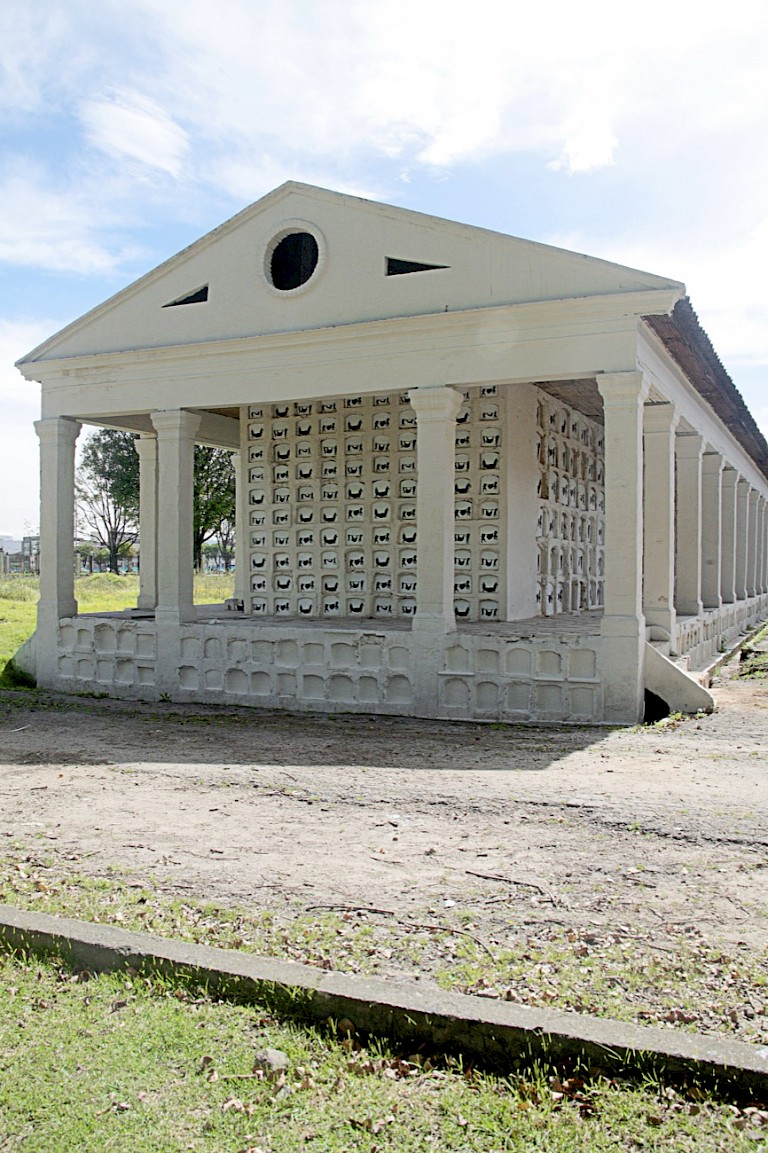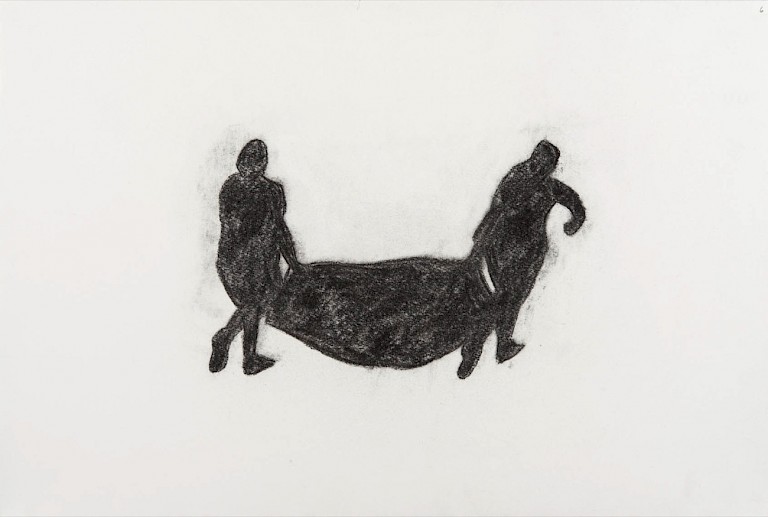



Since 2003 the artist Beatriz Gonzalez looked for ways to save the columbaria since they were endangered as an architectural venue. Because of its original status, the buildings could be modified or destroyed so long as the changes did not affect the main globe of the Central Cemetery. In 2007 Gonzalez had an idea to create a project that could bring attention to the columbaria as a place of memory and art-led urbanism or place-making. Gonzalez collected images from different newspapers that showed the realities of the armed conflict in Colombia. She then made a selection and made eight silhouettes inspired in the photographs. The images showed the way in which people carried dead bodies out of conflict zones, which are recurrent in the news.
Later on, she hired a workshop dedicated to tombstones making, to reproduce the 8,957 manual-made silkscreens, which were needed to seal every hole of the empty columbaries. The production and installation of the tombstones took around two years to complete. It was made thanks to a 174 million Colombian pesos (approx $41.336 USD) public tender from the district that was attributed to the artist to complete the project.
The structures were saved for a few years but a few district administrations continued planning to tear down the project even after the work had been installed. The idea was finally put aside when in 2019 the entirety of the piece, as a site-specific installation project, was declared National Heritage. Nonetheless, the artist clarified it was not easy. She brainstormed with the gallery that represents her in Bogota to find options to save the work she had originally made, along with the structure of the columbaria as a venue for community and memory. It took the research and collaboration between Beatriz Gonzalez, the Ministry of Culture, and the CDPC (Cultural Heritage District Council) to be able to declare the columbaries with her work as National Heritage and part of the Affected Area of the Central Cemetery.
In terms of Urbanism, the columbaria used to be part of the influence zone of the Central Cemetery (already part of the National Heritage program) but were not protected as cultural heritage. However, the artist's goal was to have them declared as part of the Affected Area which meant that the columbaria needed to be protected and taken care of. Her artwork contributed to this profoundly.
In 2019 her work was declared as national heritage. That same year the Colombian peace treaty was signed between the government and the FARC guerrilla group, and a healing space was more needed than ever before. This increased importance of the work for the population and its symbolic weight. The Centre of Memory, Peace, and Reconciliation was later on located right next to it and which nowadays oversees the access to the monument. This centre is dedicated to mediating the difficult conversations that come with the conflict in the country and its peace process.
After a few attempts to tear down the neoclassical buildings which had, for years, been a symbol of the death of anonymous peoples in Colombia's internal conflicts, the artwork Auras Anónimas (Anonymous Auras) and the columbaria were saved by being declared National Heritage. The artwork recovered the importance of the set of buildings since it re-acknowledged the importance of a grieving space for the community through creativity, art-led urbanism, and place-making. The current Mayor of Bogota, Claudia Lopez, referred to the Columbaries as representing a space of reflection on a time of conflict. Many have found peace in it, or the start of a healing process when walking around them.
The Colombian artist Humberto Junca talks about this piece as an exercise of memory. Given that sometimes being in the city can separate the people from the ongoing war, which is mainly fought in the countryside, this monument is a way of remembering the victims who live closer to the conflict. This was the first memorial monument of the ongoing conflict in Colombia, and now the main piece of the Centro de Memoria, Paz y Reconciliation (Museum of Memory).
The original artwork has been adjusted to be exhibited in different solo and collective artistic shows, one of which was a retrospective of the work at the Public Prosecutor's Office. Another example is the exhibition ‘Brumas’ at Fragmentos, a place dedicated to art and memory in Bogota designed by artist Doris Salcedo in 2022. It was also featured at the Beatriz Gonzalez retrospective exhibition at the Museum of Fine Arts in Houston and the MAMU at the Central Bank of Colombia’s museums. Doris Salcedo has referred to the images of Auras Anónimas (Anonymous Auras) as “... a very beautiful way to portray war without showing it.”
What started as a two-year temporary experimental piece of the artist has proven over time to be a space that builds community and heals families; its symbolic value has only increased since it was declared national heritage in 2019 and after becoming a central piece of a museum that focuses on honouring the victims of the war. Finally, together with the gallery Casas Reigner, the artist wrote a book addressing the importance of the monument and the long fight she had to give to save the columbaria and her work. In 2020, as a final step to preserve the monument, the state declared the Columbaria with Auras Anónimas (Anonymous Auras) an asset of cultural interest.
González occupies a central role in the history of contemporary Colombian art. As early as 1962 she reinterpreted Western art’s iconic works to reflect upon ways in which high culture was assimilated in Colombia. She created a unique visual language informed by her fascination with the notion of "taste" using found images, a bold color palette and the creation of flat compositions carried out on unconventional supports including furniture pieces, bed covers, and oversized curtains. Her unique perspective on Colombia’s popular culture and politics is key in her artistic voice that has resonated internationally.
Her work is part of collections such as Tate Modern (London, UK), Museum of Fine Arts (Houston, USA), Deutsche Bank (Frankfurt, Germany), MoMA (New York, USA), Museo Nacional Centro de Arte Reina Sofía (Madrid, Spain), Museo Nacional de Colombia, Banco de la República, Museo de Arte Moderno de Bogotá, (Colombia). She has participated in the 11th Bienal de São Paulo (1971), 38th Venice Biennale (1976), 8th Berlin Biennale (2014), and Documenta 14, Kassel (2017). Since 1983 she has curated numerous exhibitions in Colombia and has published monographs on individual artists, including Luis Caballero (1943–1995).




